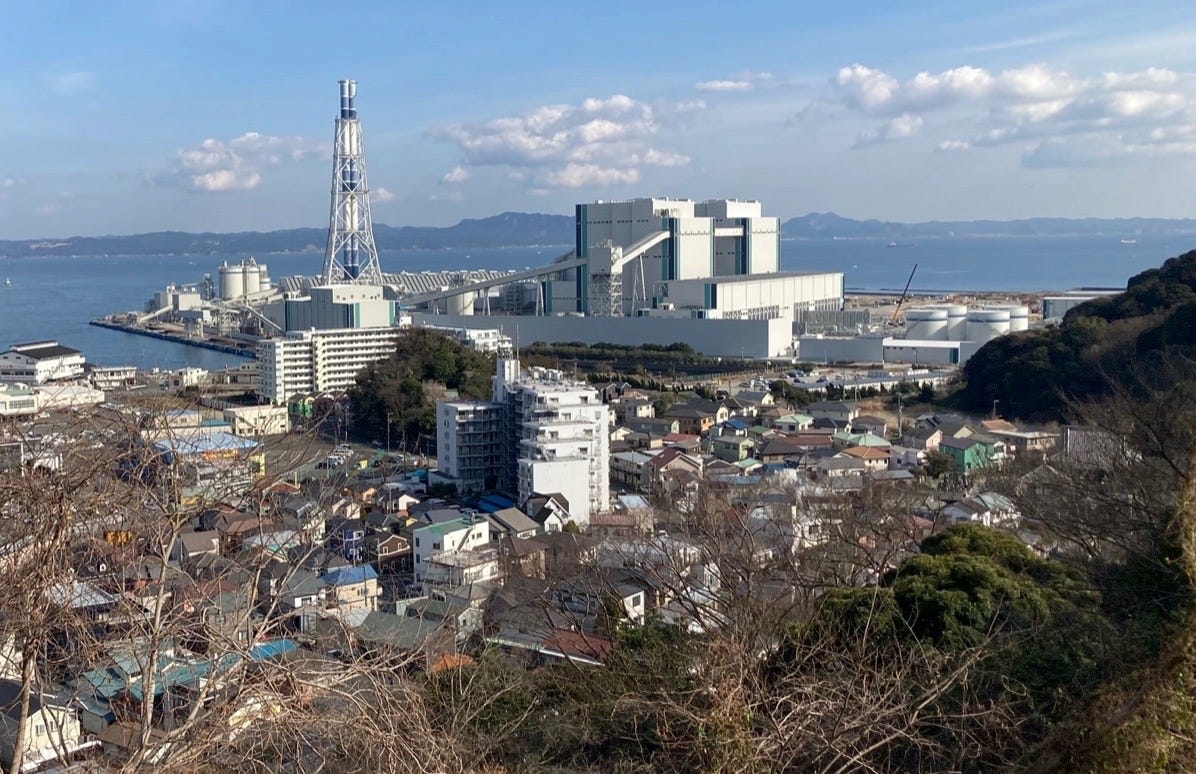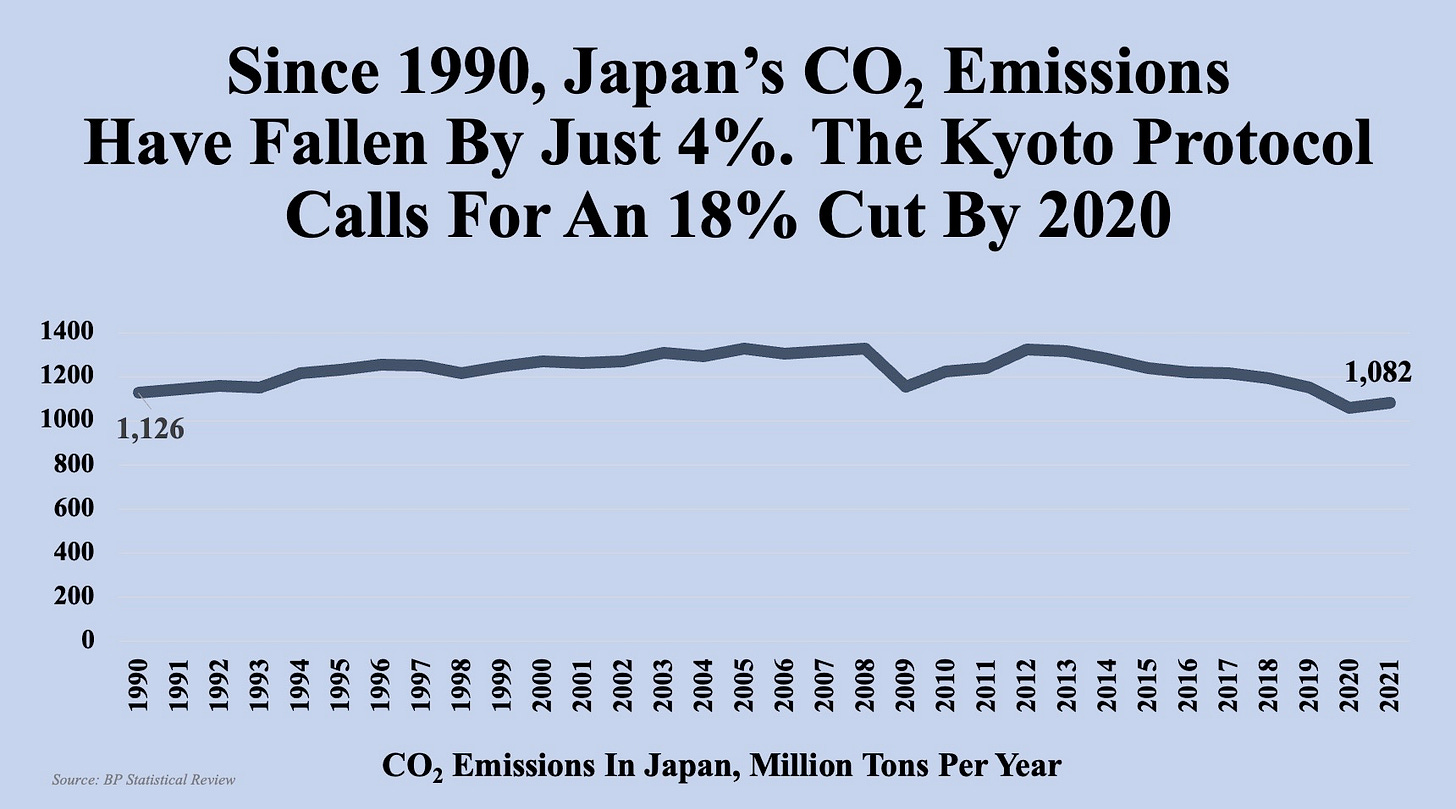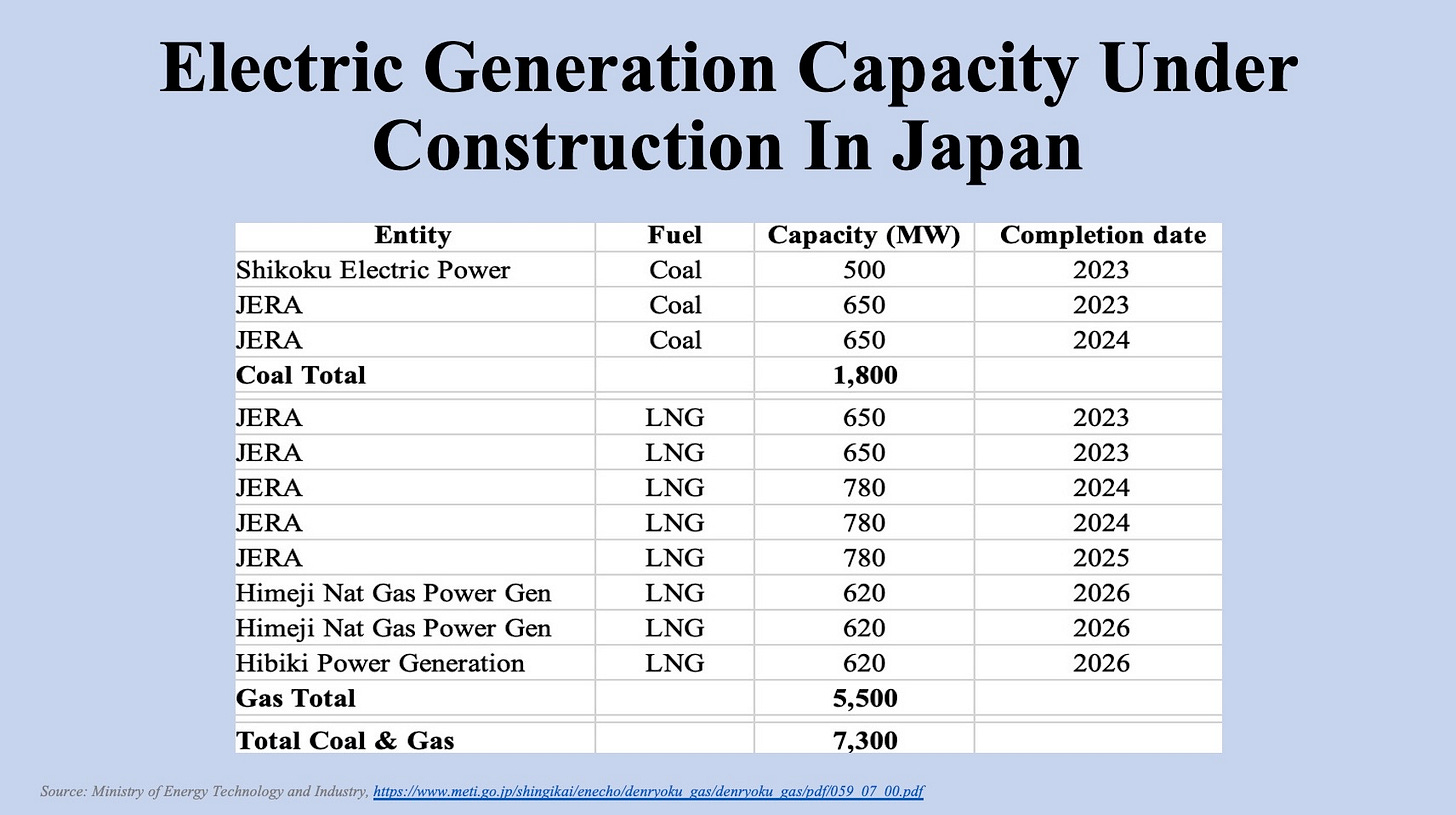Japan No Kyoto (Or Net Zero)
Twenty-six years after the Kyoto Protocol, drastic action on climate change is more like “a dream than a reality.”

In January, during the Davos confab, the World Economic Forum published an article touting Japan’s action on climate change. It was headlined, “How Japan is accelerating efforts toward a carbon-neutral society.”
It said that “In the face of the climate crisis, 136 countries around the world have pledged to reach net zero by 2050. This includes Japan, which is on the path to carbon neutrality with an interim goal of reducing greenhouse gas emissions by 46% compared to 2013 levels by 2030.” It continued, saying that the Japanese government, has created a “green innovation fund” that aims to spend some $15 billion on “areas essential to the circular economy, such as storage batteries, offshore wind power, next-generation solar cells, hydrogen, and carbon recycling.”
On its website, Japan’s Ministry of Foreign Affairs notes that in addition to the federal government’s declaration that it will achieve net zero by 2050, “More than 281 cities/local governments declared net zero by 2050,” and this covers more than 100 million people, or “about 80% of Japan’s population.”
But 26 years after the Kyoto Protocol––the most famous document adopted under the United Nations Framework Convention on Climate Change––was agreed to in Kyoto in 1997, the numbers, and the reality on the ground in Japan, show that talk about bold action on climate is cheap. Actually cutting emissions is a different story.
Rather than slash its emissions by at least 18% below 1990 emissions levels by 2020, as was specified at the COP18 meeting in Doha, Japan’s emissions are still at roughly the same level as they were in 1990. As can be seen in the graphic above, Japan’s emissions in 2021 were just 4% lower than they were in 1990. (For Kyoto signatories and commitments, click here.)
I have spent the past week in Japan. My visit was sponsored by the Federation of Electric Power Companies of Japan and facilitated by Washington Policy and Analysis. I was part of a group of five Americans who were given the chance to see the cleanup efforts at Fukushima Daiichi. We saw the sprawling operations of Japan Nuclear Fuel Limited in Aomori Prefecture, which includes a uranium enrichment plant, high- and low-level radioactive waste disposal, and other facilities, including a plant under construction that will reprocess spent nuclear fuel. We also met with industry leaders and Japanese government officials.
As I wrote in these pages a few days ago, the visit to Fukushima Daiichi was a sobering experience. I saw firsthand the damage caused by the nuclear accident and the devastation caused by the tsunami which killed some 19,000 people. The visit to JNFL’s facility in Aomori was equally eye-opening. Japan’s electric utilities are spending some $20 billion on a state-of-the-art complex that could eventually manage the entirety of Japan’s nuclear fuel cycle, except for the supplies of uranium. The scale of the project is massive and is concrete proof of Japan’s ability to execute large, forward-looking, highly technical, multi-year infrastructure projects. (Seeing it also increased my skepticism that the U.S. Congress will be able to muster the political will to plan, fund, and execute a similar project.)
My takeaway from all of those visits and discussions, as well as what I have seen here in Tokyo and around the country, is that energy realism in Japan is trumping action on climate change. It provided yet more proof for Roger Pielke Jr.’s Iron Law of Climate Policy, which says that “When policies focused on economic growth confront policies focused on emissions reductions, it is economic growth that will win out every time.”
Before going further, let me stipulate that solar is growing here. According to BP, solar capacity in Japan tripled between 2014 and 2021 and now stands at about 75 gigawatts. In 2021, Japan generated 86 terawatt-hours of energy from solar, which was about half the amount generated in the U.S. That’s an impressive achievement. But Japan can’t run its economy on solar. Furthermore, Kyushu Electric Power Company isn’t adding any more solar capacity because its system can’t accommodate any more of it. Meanwhile, Japan’s wind capacity is small (about 4 gigawatts) and is constrained by local opposition and the country’s mountainous topography. The country can’t tap its geothermal resources because of public opposition.
What about adding more nuclear? Japan is reactivating many of its existing reactors. But it won’t be adding any new reactors anytime soon. In more than half a dozen meetings with business and government leaders, I asked the same question: In the best-case scenario, how soon might Japan build a new reactor? The answer from all of them was the same: 15 to 20 years.
Thus, unable to build more renewable or nuclear capacity, Japanese utilities are building 7.3 gigawatts of new generation capacity that will burn hydrocarbons. (For comparison, the four ruined reactors at Fukushima Daiichi had a total capacity of about 2.7 gigawatts.)
JERA is building a big coal plant in Tokyo. The Yokosuka plant will have two ultra-supercritical generators and a total capacity of 1.3 gigawatts. Shikoku Electric Power is building a 500-megawatt coal plant in Saijo. Like the Yokosuka plant, it will use ultra-supercritical technology, which is the most efficient way to burn coal. In addition, as can be seen in the list above, (data is here) Japanese utilities are building eight new gas-fired power plants that will have a total capacity of 5.5 gigawatts. When I showed the list of power plants to a friend in the utility sector last Friday, he nodded his head, smiled, and said, “Yes, this is the reality today in Japan.”
After the meeting ended, the same official took me aside and quietly said that despite government pronouncements, “Net zero is really more like a dream than a reality.”
Another key theme I heard many times during our meetings last week was that Russia’s invasion of Ukraine has fundamentally changed Japan’s energy plans. One government official was blunt, saying “Energy security is more important than action on climate change.” After the meeting ended, the same official took me aside and quietly said that despite government pronouncements, “Net zero is really more like a dream than a reality.”
As for Japan’s 4% drop in emissions, my Japanese friends advised me that that reduction was largely due to a slowdown in the country’s economy, not any government efforts. They also said Japan will not rely on China for the commodities it will need to move to alternative energy. Japan has a long history with China and nearly all of it is bad. As I explained back in January, China has a stranglehold on the rare earth elements and high-strength magnets that are needed for many alt-energy technologies. In 2010, China blocked exports of rare earths to Japan and kept export restrictions in place until 2014.
In addition to China, Japan’s other neighbors (Russia and North Korea) aren’t exactly Ozzie and Harriet. In short, Japan will look after Japan. And any serious action on climate change will remain more like “a dream than a reality.”




Since economics trumps politics, I believe the people who expect a 15-20 year delay before new nuclear may be overly pessimistic.
When Russia exposed the world's vulnerability a disruption in the supply of it fuel, the cost of all hydrocarbons, including coal, skyrocketed. When Europe was building its winter inventory last summer, it was physically challenging for all other countries to arrange fuel deliveries because European traders we willing to, and could afford to, outbid most other customers.
Countries dependent on imported fuel were temporarily saved by a warm winter and by the fact that most of Russia's fuel is still finding its way into the market.
Do economics, including a risk premium, really favor an increasing dependence on fossil fuel? Will that remain true if nuclear plants are built competently, with a national priority that speeds up approvals and mutes obstruction?
Pielke: “When policies focused on economic growth confront policies focused on emissions reductions, it is economic growth that will win out every time.”
Hargraves: "Economics trumps politics"